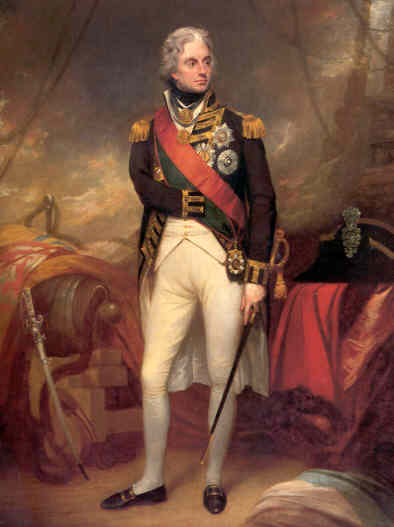Lord Horatio Nelson is still viewed as one of the greats in British history and, as a result, his portraits throughout time reflect an almost divine man. It is natural that he would be depicted as the hero that the public wanted to see. He is tall with perfect skin and is decked out in his prim and proper military uniform. Though many of the portraits do portray his missing arm, Nelson actually physical showed his battle experiences and was even blind in one eye. But why would this be portrayed in a portrait? It does not follow the narrative that is meant to be presented.

Yet, a new portrait has been uncovered which may show more of the real Nelson. It was painted by Leonardo Guzzardi in 1799 and throughout time the scars that were depicted originally were covered up by various owners. Through restoration efforts, art historians have uncovered these lost facial features. In Guzzardi’s version, Nelson actually looks battle harden with his large scar and missing eyebrow. He begins to look more human than the divine hero he was made to look like. Whoever owned this portrait did not like the more realistic portrayal and covered up the scar and filled in the eyebrow. To me, it is interesting how portraiture was used to craft history even after the subject had died. It is also interesting how people after you can still influence your memory.

Who was Lord Nelson?
Soldier, Strategist, Leader
Nelson is mostly commonly known as the great hero of the Napoleonic Wars. He began his navy career at the young age of 12 and by the age of 20 he would reach the rank of captain. He fought in the West Indies during the American Revolution against France and Spain. Later, in the 1780s, Lord Nelson would go on to make enemies as he strongly enforced the Navigation Acts against American ships who attempted to trade with the British. He would anger merchants and British officials who were still trying to make money despite the law.
Returning home with a new wife in tow, Nelson found that due to his actions in the West Indies he was left without a new commission. He remained unemployed for another five years until the French Revolutionary Wars broke out.
Nelson was given command of the 64-gun Agamemnon and used the French Revolutionary Wars to prove himself. He was stationed in the Mediterranean to fight the French and protect the British allies.
Nelson went through a lot during his time in the Mediterranean. He lost his right eye during the siege of Calvi and later lost his right arm after leading the unsuccessful assault on Santa Cruz de Tenerife. On April 14, 1797 Nelson disobeyed orders and led a seemly suicide expedition against the entire Spanish squadron of ships ruining their plan of surprise attack. As a result the British were victorious at the Battle of Cape St Vincent. Nelson was knighted and promoted to rear admiral. Nelson proceeded to chase the French to Egypt where they became trapped and Nelson’s fleet all but destroyed them. After the Victory of the Battle of the Nile, Nelson was made a baron.
He began a scandalous affair with the wife of a British minister, Emma Hamilton, and was about to be punished by the British government for disobeying orders while in Naples. Instead, his popularity won the day and he received the vice admiral position.

In 1803, after Napoleon Bonaparte became emperor, Nelson blockaded the French port of Toulon and this would hold (trapping the French) until 1805! At that time the French admiral Villeneuve used cover of darkness to finally escape the blockade.
What Lord Nelson is most famous for is his victory at Trafalgar. Nelson was facing the Franco-Spanish fleets and formed two divisions out of his 27 ships. From his ship Victory, he sent the message “England expects every man to do his duty.” After five hours of fighting the British destroyed 19 enemy ships and captured the French admiral, Villeneuve (the one who escaped the blockade earlier). No British ships were lost that day, but there were 1,500 casualties including our hero Nelson himself. He was shot by a French sniper and died just before the end of the battle. His last words, allegedly, were “Now I am satisfied. Thank God I have done my duty.” The Battle of Trafalgar ensured that Napoleon would never be able to invade England and Nelson was viewed by the British as the savior of their nation. There is a column built to his memory in Trafalgar square and his ship the Victory is preserved at Portsmouth.

I find it interesting that throughout time portraits can be influenced depending on how one was viewed in life. A heroic look replaced the human portrayal of Lord Nelson, yet I feel the battle scars that Nelson retained could also show a battle harden hero in a different way. It shows an experience soldier who achieved these great victories, but not without cost. What do you think of the different portrayals of Lord Nelson?
Sources:
https://www.smithsonianmag.com/smart-news/new-portrait-lord-nelson-found-scars-and-all-180967205/
http://www.bbc.co.uk/history/historic_figures/nelson_admiral_horatio_lord.shtml
https://www.history.com/this-day-in-history/lord-nelson-born
https://www.britannica.com/biography/Horatio-Nelson-Viscount-Nelson#ref5164
Thanks for this really well-written and fascinating post on the life of Lord Nelson! I had no idea that his real physical appearance was so different than the historical paintings. I wish I had read your post when I was researching Nelson prior to my latest post. You might find it interesting, though:
Thetis Delivered Achilles’ Shield to… Lord Nelson at Trafalgar?
LikeLiked by 1 person
Thank you! I am glad you enjoyed my post. I will definitely check out your article! 🙂
LikeLiked by 1 person